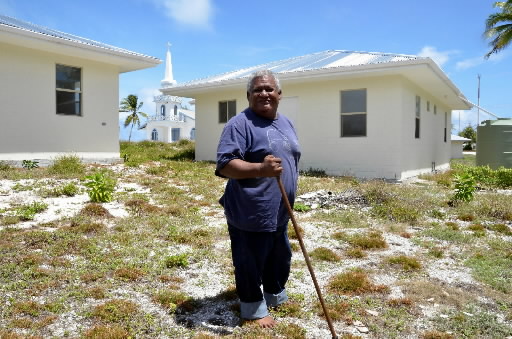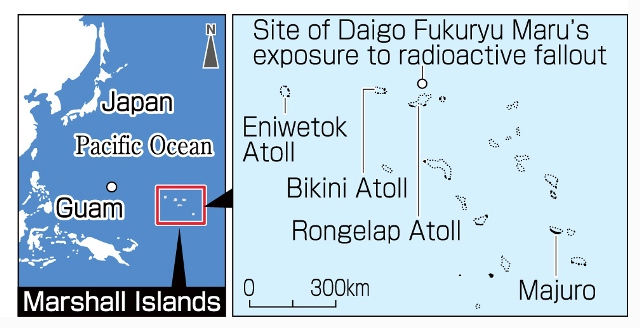Far from Home: 60 Years After the H-bomb test at Bikini Atoll, Part 1
Mar. 20, 2014
New houses, but residual radiation keeps people from returning
by Jumpei Fujimura, Staff Writer
The coral reefs of the Marshall Islands spread out like a string of necklaces in the Pacific Ocean. As a result of the radioactive fallout caused by a hydrogen bomb test performed by the United States at Bikini Atoll on March 1, 1954, the islanders were forced to flee this part of the Pacific. Even today, 60 years later, they are reluctant to return to their homes. The Chugoku Shimbun reports on current conditions in the Marshall Islands.
Rongelap Atoll is located about 170 kilometers east of the Bikini Atoll, the site of the hydrogen bomb test. The tin roofs of the brand-new houses shine in the bright tropical sun. The palm trees sway in the breeze. It has all the appearance of a peaceful resort, except for the radioactive fallout that still lingers in the area.
There are 49 of these single-story houses. Each home has three bedrooms, a living room, a dining room, a kitchen, two bathrooms, and two toilets to accommodate a large family and other relatives. Water and electricity are free. Even food is provided. Yet most of these homes remain vacant.
The Rongelap Atoll Local Government has been promoting resettlement since 1998. “Aren’t they nice houses? The plan has been smoothly implemented,” said Fred Anjain, 56, showing me the residential area. He is overseeing the resettlement plan.
The United States provided a total of 45 million dollars (approximately five billion yen at the exchange rate in 1998) to support the plan. The main projects, building houses and infrastructure, were mostly completed about two or three years ago. In an effort to decontaminate the residential area, about 25 centimeters of soil was removed from the surface of the ground, and coral gravel has been laid to cover the earth. Potassium, which absorbs radiation, is spread at the foot of the palm trees near the houses. It seems that everything is ready for people to return.
This month the Japan Council against Atomic and Hydrogen Bombs (Gensuikyo) visited Rongelap Atoll and measured the levels of radiation at 36 places on the island. The radiation level around the residential area was about 0.015 microsieverts per hour, which is within the annual permissible level of 0.15 millisieverts in the United States. In the northern forest area outside the residential area, however, the radiation level was 0.043 microsieverts, which is about three times as high, and higher than the annual permissible level.
“The islanders eat coconuts and other things. It is not yet known, scientifically, how internal exposure to radiation affects people’s health over a prolonged period of time,” said Mineo Kato, 69, who is a member of Gensuikyo and a former engineer at the Japan Atomic Energy Agency, located in Tokaimura, Ibaraki Prefecture.
According to Mr. Anjain, about 30 people live temporarily on the island, many of whom are originally from Rongelap Atoll. All of them are workers engaged in the resettlement plan and their family members. Melinda Boas, 45, moved here with her husband and her eldest son, who is 12 years old, from Mejatto Island, where many former islanders live. “Life here is more comfortable,” she said, smiling.
The workers and their families receive examinations for internal exposure once every few months, using a whole body counter installed on the island by the U.S. Department of Energy. “This way, we won’t have any problems,” Mr. Anjain stressed, saying that he would like to see more new houses built. He mentioned many times how much he loves the island.
The Rongelap Atoll Local Government has urged people to return, but few of the former islanders are willing. They say they are afraid of radiation, which threatens their health, and that the new generations do not want to be resettled. Brand-new homes, sitting empty, reveal the reality of the island, whose destiny has been altered utterly by the nuclear test.
Keywords
Nuclear tests in the Marshall Islands
The United States carried out 67 atomic and hydrogen bomb tests from 1946 through 1958 on the two atolls of Bikini and Enewetak in the Marshall Islands, located in the Pacific Ocean. (One test was conducted in the air.) Most notably, the “Bravo” hydrogen bomb test at Bikini Atoll conducted on March 1, 1954 released a large amount of nuclear fallout. The explosive power of the bomb was 15 megatons, which is about 1,000 times as powerful as the atomic bomb dropped on Hiroshima. The residents of Rongelap Atoll, located downwind, were exposed to radiation since no evacuation warning was issued in advance. Crew members of the Daigo Fukuryu Maru (Lucky Dragon No. 5), a Japanese tuna fishing boat sailing in the ocean, were also exposed to radiation. Aikichi Kuboyama, the chief radio operator, died six months later. Radioactive fallout contaminated many fishing boats, and many tuna had to be disposed of. It has been learned from official U.S. documents that an extensive area, including the U.S. mainland and Japan, was contaminated by radioactivity.
(Originally published on March 15, 2014)
by Jumpei Fujimura, Staff Writer
The coral reefs of the Marshall Islands spread out like a string of necklaces in the Pacific Ocean. As a result of the radioactive fallout caused by a hydrogen bomb test performed by the United States at Bikini Atoll on March 1, 1954, the islanders were forced to flee this part of the Pacific. Even today, 60 years later, they are reluctant to return to their homes. The Chugoku Shimbun reports on current conditions in the Marshall Islands.
Rongelap Atoll is located about 170 kilometers east of the Bikini Atoll, the site of the hydrogen bomb test. The tin roofs of the brand-new houses shine in the bright tropical sun. The palm trees sway in the breeze. It has all the appearance of a peaceful resort, except for the radioactive fallout that still lingers in the area.
There are 49 of these single-story houses. Each home has three bedrooms, a living room, a dining room, a kitchen, two bathrooms, and two toilets to accommodate a large family and other relatives. Water and electricity are free. Even food is provided. Yet most of these homes remain vacant.
The Rongelap Atoll Local Government has been promoting resettlement since 1998. “Aren’t they nice houses? The plan has been smoothly implemented,” said Fred Anjain, 56, showing me the residential area. He is overseeing the resettlement plan.
The United States provided a total of 45 million dollars (approximately five billion yen at the exchange rate in 1998) to support the plan. The main projects, building houses and infrastructure, were mostly completed about two or three years ago. In an effort to decontaminate the residential area, about 25 centimeters of soil was removed from the surface of the ground, and coral gravel has been laid to cover the earth. Potassium, which absorbs radiation, is spread at the foot of the palm trees near the houses. It seems that everything is ready for people to return.
This month the Japan Council against Atomic and Hydrogen Bombs (Gensuikyo) visited Rongelap Atoll and measured the levels of radiation at 36 places on the island. The radiation level around the residential area was about 0.015 microsieverts per hour, which is within the annual permissible level of 0.15 millisieverts in the United States. In the northern forest area outside the residential area, however, the radiation level was 0.043 microsieverts, which is about three times as high, and higher than the annual permissible level.
“The islanders eat coconuts and other things. It is not yet known, scientifically, how internal exposure to radiation affects people’s health over a prolonged period of time,” said Mineo Kato, 69, who is a member of Gensuikyo and a former engineer at the Japan Atomic Energy Agency, located in Tokaimura, Ibaraki Prefecture.
According to Mr. Anjain, about 30 people live temporarily on the island, many of whom are originally from Rongelap Atoll. All of them are workers engaged in the resettlement plan and their family members. Melinda Boas, 45, moved here with her husband and her eldest son, who is 12 years old, from Mejatto Island, where many former islanders live. “Life here is more comfortable,” she said, smiling.
The workers and their families receive examinations for internal exposure once every few months, using a whole body counter installed on the island by the U.S. Department of Energy. “This way, we won’t have any problems,” Mr. Anjain stressed, saying that he would like to see more new houses built. He mentioned many times how much he loves the island.
The Rongelap Atoll Local Government has urged people to return, but few of the former islanders are willing. They say they are afraid of radiation, which threatens their health, and that the new generations do not want to be resettled. Brand-new homes, sitting empty, reveal the reality of the island, whose destiny has been altered utterly by the nuclear test.
Keywords
Nuclear tests in the Marshall Islands
The United States carried out 67 atomic and hydrogen bomb tests from 1946 through 1958 on the two atolls of Bikini and Enewetak in the Marshall Islands, located in the Pacific Ocean. (One test was conducted in the air.) Most notably, the “Bravo” hydrogen bomb test at Bikini Atoll conducted on March 1, 1954 released a large amount of nuclear fallout. The explosive power of the bomb was 15 megatons, which is about 1,000 times as powerful as the atomic bomb dropped on Hiroshima. The residents of Rongelap Atoll, located downwind, were exposed to radiation since no evacuation warning was issued in advance. Crew members of the Daigo Fukuryu Maru (Lucky Dragon No. 5), a Japanese tuna fishing boat sailing in the ocean, were also exposed to radiation. Aikichi Kuboyama, the chief radio operator, died six months later. Radioactive fallout contaminated many fishing boats, and many tuna had to be disposed of. It has been learned from official U.S. documents that an extensive area, including the U.S. mainland and Japan, was contaminated by radioactivity.
(Originally published on March 15, 2014)









